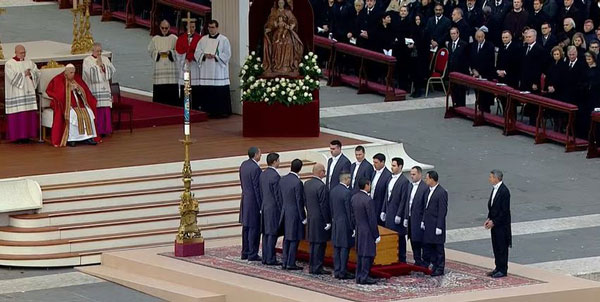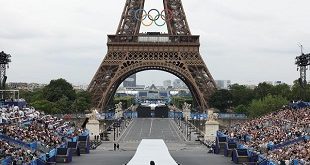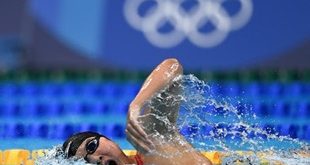
Pope Francis extols Benedict XVI as pastor in historic two-pope Vatican funeral
✳ 4,500 priests
✳ 500 bishops
✳ 125 cardinals
Vatican City | National Catholic Online | In one of the rarest of scenes in two millennia of Catholic Church history, Pope Francis on Jan. 5 presided over the funeral Mass of his predecessor, the late Pope Benedict XVI, and offered a subtle send-off to someone he extolled as a pastor who “spread and testified” to the Gospel for his entire life.
During a brief, seven-minute homily to a crowd of thousands gathered during a cool, foggy morning in St. Peter’s Square, Francis reflected on the life of Christ, marked by “hands of forgiveness and compassion, healing and mercy, anointing and blessing,” seemingly drawing a parallel to the same devotion in which Benedict served the church.
“God’s faithful people, gathered here, now accompanies and entrusts to [God] the life of the one who was their pastor,” said Francis of Benedict, who reigned as the head of the global Catholic Church from 2005-13. Prior to that, the former Cardinal Joseph Ratzinger had been at the levers of power of the institution for some five decades, as a noted theologian and then the long-time head of the Vatican’s powerful doctrinal office.
The Jan. 5 funeral brought the final end to a near decade-long era, where from 2013 a former pope, the late Benedict who shocked the world with his resignation that year, lived within a monastery inside the Vatican under the title of “pope emeritus,” while the reigning pope, Francis, lived only a few steps away.
During the Mass, Francis focused his reflections primarily on the life of Christ – a theme frequently explored by the late pope, including in a trilogy of books on “Jesus of Nazareth,” which he penned during his nearly eight-year papacy – rather than dwelling on the contours of the predecessor’s long life and influence.
In the years since Benedict’s resignation, Francis has referred to his predecessor as a “grandfather of all grandfathers” and often praised the wisdom Benedict offered as a retired pope living inside the Vatican walls. At the same time, some traditionalist Catholics critical of Francis’ liturgical reforms and pastoral priorities — and those opposed to papal resignations — viewed the former pope’s presence, at least symbolically, as a counter witness to the Francis papacy.
In the homily for the funeral Mass, Francis seemed inclined to focus on more basic matters – leading the people in St. Peter’s Square and Catholics watching around the world in praying for God to welcome Benedict home.
Invoking the image of the women in the Gospel stories who incensed the tomb of the deceased Jesus, Francis said “we too have come with the fragrance of gratitude and the balm of hope, in order to show once more the love that is undying.”
“We want to do this with the same wisdom, tenderness and devotion that [Benedict] bestowed upon us over the years,” said Francis. “Together, we want to say: ‘Father, into your hands we commend his spirit.'”
Some 4,500 priests took part in the funeral Mass, joined by about 500 bishops and 125 cardinals, among them, 90-year-old Cardinal Joseph Zen of Hong Kong, who received special court permission to travel to Rome for the occasion, after being recently convicted by the Chinese Communist Party for his efforts backing democratic reforms in China’s special administrative region. All seven residential U.S. cardinals were also in attendance for the funeral.
The scene in St. Peter’s Square, although momentous, marked a sharp contrast from the last time a pope was buried here in 2005, when the funeral of the late Pope John Paul II brought some five million visitors to Rome, with more than 300,000 filling the square for what was described at the time as “history’s largest funeral.”
At least 70 presidents and prime ministers, as well as dignitaries from over 100 countries, were on hand to mark the end of one of the Catholic Church’s longest pontificates, where crowds famously shouted “santo subito” — indicating their support for John Paul to be made a saint immediately.
Ratzinger, as the then dean of the College of Cardinals, celebrated the Mass and preached the homily and then 11 days later, on April 19, 2005, was elected Pope Benedict XVI, becoming the first German to be elected pope in over a thousand years.
When he appeared on the loggia of St. Peter’s Basilica overlooking the square below, he pledged to be “a simple and humble laborer in the vineyard of the Lord.”
Eighteen years later, mourners and Catholic faithful again filled that same square for his funeral, which, according to his wishes, took place in the style of “simplicity,” where a cypress coffin, placed inside a zinc coffin, sealed in a wooden casket, contained his mortal remains.
#PopeFrancis at funeral: "Benedict, faithful friend of the Bridegroom, may your joy be complete as you hear his voice, now and forever!" pic.twitter.com/6alGqHlFpZ
— Cindy Wooden (@Cindy_Wooden) January 5, 2023
Although some conservative voices expressed upset online at the brevity of Francis’ homily for the funeral, the pope is known to primarily use his homilies to reflect on the readings of the day. In his 2018 homily during the canonization Mass for slain Salvadoran Archbishop Oscar Romero, for example, Francis focused mostly on the universal call to holiness, and devoted about one line specifically to Romero.
Tens of thousands were present in St. Peter’s Square Jan. 5 to witness an occasion that historians say has very little precedent. Before Benedict, the last pope to resign had been Gregory XII, who was forced to step down in 1415 to end a schism. The last pope to resign voluntarily had been Celestine V, in 1294.
Miles Pattenden, a scholar of the papacy at Australia Catholic University, told NCR the last time a reigning pontiff played a role in the funeral of his predecessor was in 1802, when Pius VII took part in the funeral of Pius VI, who had died under duress after being kidnapped in Rome by French troops commanded by Napoleon Bonaparte.
Pius VI had died as a prisoner in France in 1799, but his body was reburied in Rome in 1802, at a funeral attended by Pius VII. “It’s a good comparison, if not a perfect analogy,” Pattenden said of the parallel with Francis celebrating Benedict’s funeral.
Christopher Bellitto, a church historian at Kean University in New Jersey, said: “Typically we need to bury one pope before we get the next one and that takes time.” Belitto also noted that papal funerals are typically followed by a conclave to elect the next pope.
“A papal death is a starting pistol of events, but this time the events last just a week, not a month,” he said.
The "rogito" or official summary of the papacy of #PopeBenedictXVI was placed in his casket with him last night. It highlights his work as a theologian, his ecumenical work, his relations with the Jewish community & his efforts to deal with the clerical sexual abuse scandal. pic.twitter.com/fT27x4yvRf
— Cindy Wooden (@Cindy_Wooden) January 5, 2023
Placed inside Benedict’s coffin was a one-page account of his nearly eight-year papacy, along with Vatican coins minted during his pontificate.
The brief, 1,000-word text recounting Benedict’s reign mentions especially his promotion of dialogue with “Anglicans, Jews and those of other religions” and his efforts “restarting contacts with the priests of the Fraternity of St. Pius X.”
A traditionalist group of priests started by the French Archbishop Marcel Lefebvre, the fraternity had questioned the validity of the Second Vatican Council and had been excommunicated by John Paul in the 1980s but had that punishment lifted by Benedict in 2009.
The text also mentions Benedict’s efforts on clergy sexual abuse.
While his record on the issue is contested — supporters point especially to his efforts to prosecute the serial sexual abuser Marcial Maciel Degollado, while detractors say Benedict did not do enough to hold bishops accountable for systematic cover-ups — the text says the pope “fought with firmness against the crimes committed by representatives of the clergy against minors and vulnerable persons.”
In the preceding three days ahead of the funeral, nearly 200,000 visitors passed through St. Peter’s Basilica, where his body rested in state ahead of the funeral, dressed with a miter, red vestments and black shoes, but without the pallium worn by active metropolitan archbishops.
Benedict’s funeral Mass followed the standard protocols for a traditional funeral liturgy, with the exception that there were no final prayers offered by Eastern Catholic churches or the Diocese of Rome, as those prayers are specific to the death of a reigning pope.
While the Nicene Creed was recited in Latin and the prayers of the faithful in various languages, the majority of the Mass was celebrated in Italian.
“I was sad to see so little of the German language in the liturgy, and really no suggestion of Benedict’s Bavarian roots,” liturgical scholar Rita Ferrone told NCR in advance of the funeral.
“Liturgy can be both particular and universal. It seems to me that, at least on paper, this liturgy is weighted rather heavily on the side of universality,” she observed. “Yet he was formed in that particular church, and I believe he carried it with him even though he lived and served for many years in Rome.”
After the funeral, Pope Benedict's cypress casket was taken to the grotto under St Peter's Basilica and placed in a zinc casket which was placed in an oak casket. Then he was buried. (©️📷Vatican Media) pic.twitter.com/33UGnkGZbc
— Cindy Wooden (@Cindy_Wooden) January 5, 2023
Despite the lack of German in the liturgy, the country was represented in the square, with the country’s black, red, and gold tricolor flag visible throughout the crowd. While only Germany and Italy were invited to send official state delegations to the funeral, nearly a dozen other heads of state attended in a personal capacity, along with representatives from two dozen Christian churches and ecumenical organizations.
German Cardinal Walter Kasper, the long-time head of the Vatican’s office for Promoting Christian Unity and a one-time theological sparring partner of the late pope, were among those in St. Peter’s on Monday, Jan. 2, paying tribute to Benedict. Kasper especially praised Benedict’s courage to step aside in 2005, after saying he was too weak to keep up with the demands of the papacy.
“This resignation wasn’t a sign of weakness, but a sign of strength, a greatness because he saw that he was no longer up to the challenges of being pope,” Kasper told NCR in a brief interview.
He added that Benedict’s resignation provided “a more human vision to the papacy, that the pope is a man and is dependent on his physical and mental strengths.”
In recent years, those physical failings became more apparent, with occasional visitors saying the retired pontiff struggled with the ability to speak and rare public photos of him showed a frail and feeble 95-year-old man.
On Dec. 28, Francis asked for Catholics around the world to offer their prayers for the retired pope, who he described as “very sick.” Four days later, on Dec. 31, the Vatican announced he had died at 9:34 a.m. Central European Time that morning.
As Francis offered his final tribute to his predecessor at the conclusion of his homily on Jan. 5, the pope called Benedict a “faithful friend” of God and prayed: “May your joy be complete as you hear his voice, now and forever.
*****
SOURCE: NCRonline.com
 The Independent Uganda: You get the Truth we Pay the Price
The Independent Uganda: You get the Truth we Pay the Price


